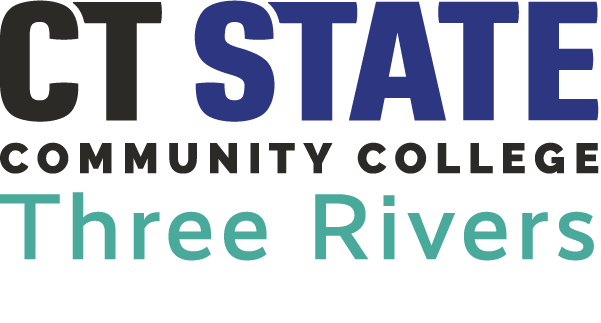In the News | SAVING OUR PLANET FROM OURSELVES
Norwich, CT (The Day, January 19, 2023) — Professor Diba Khan-Bureau of Three Rivers Community College in Norwich, a renowned environmental engineer, has spent her professional years both in the classroom and in the field, striving to preserve the health and dignity of the natural world, which our own species has so earnestly been despoiling at an alarming rate. And though our species has labored at the deplorable practice of self-serving gains – at the price of other lifeforms on Planet Earth – dedicated activists like this tireless professional stay the course for a better world.
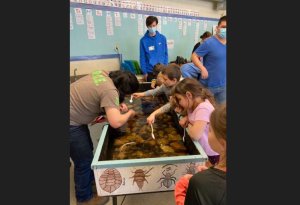
TRCC students work with first graders from Salem School, who are seen inspecting a river simulator last year.
A onetime environmental engineer for Electric Boat in Groton (mid 1990s), Dr. Khan-Bureau sought to make more of a significant impact in the critical areas of hazardous waste removal, air compliance and, above all, the ever-looming menace of climate change, which she feels must be taken far more seriously.
“While at EB and managing hazardous waste, I dealt with harmful constituents that are commonly found in industrial manufacturing,” she explained. “Certain states, including Connecticut, have strict regulations for this process.”
Professor Khan-Bureau makes it clear that many of us are unaware of harmful products we are exposed to daily, such as plastics, which she states are, “showing up everywhere.” And as necessary and important the work this energetic and still young professional was doing for Electric Boat, Diba Khan-Bureau felt she could make more of an impact as a scientist functioning out in the actual field.
“I fear we are systematically impacting our environment negatively and we need to do something about that now. Herbicides and pesticides are destroying insect species. This sort of behavior must be addressed if we are to keep our world healthy. But it’s extremely difficult to change people’s thinking when you consider there are many countries (80%) that actually include insects as a part of their daily diets.”
The gravity of the rising crisis of our kind’s habitually destructive activities impelled the young professor into becoming a more practicing activist in the field of environmental engineering—leading not only into groundbreaking scientific discoveries of her own, but also into the ultra-important area of education and enlisting eager students into the field as well.
“I was credited with the discovery of a new species of diatoms: the Didymosphenia Hullii.” (For those of us not entirely tuned into scientific jargon, a diatom is a photosynthetic single cell organism … of which there are millions!) And Khan-Bureau is among those knowledgeable enough, active enough, and keen enough in her profession to have made such a discovery.
She not only continues with her invaluable contributions in studying and helping protect the natural world — to which she has devoted a lifetime — she has now also encouraged and mobilized a corps of climate and field warriors, forming a veritable student army of environmental science majors at Three Rivers Community College.
“I’m teaching them about the science involved and the regulations that are crucial both nationwide and worldwide regarding the concerns of today,” Khan-Bureau said. “That includes biodiversity decline, water and air pollution, and the peril of invasive species to name only some of the studies involved. My students and I also vibracore (technique for collecting core samples from riverbeds) into the earth to determine how long these species of nuisance diatoms have been in the Farmington River in Connecticut.”
In essence, this particular professor has transcended the classroom by mustering together and leading a team of budding young students that now share her longtime commitments and convictions.
“Everyone needs to take more seriously our responsibilities to this planet,” she explained with an iron passion that runs deep and sincere. “I don’t think everyday people are deliberately trying to ruin the environment, but the public needs to be better educated about our ecosystem and the services it provides for us, while large corporations must be more mindful of consequences.”
Undeterred by the vitriol spewing out from crass radio and television talk show hosts — and from shortsighted legislators who treat the climate change crisis like the punchline of a crude joke, Khan-Bureau forges ahead with her rapidly rising army of staunch science activists committed to the rescue of our natural world . . . and our future.
“I believe in humanity and in the people who are truly concerned. The beautiful thing about education is that it opens the door to knowledge and opportunity. We’ll find a way,” she added with a smile of quiet confidence.
Our planet has a potent player in this woman—and those who are now following the path that led her to a life of purposeful passion. Doctor Diba Khan-Bureau is training them to care enough about what’s happening to our planet and encouraging them to enter an arena where they might assist in turning it around on behalf of a world in dire need of help.
“Well find a way,” this sincere crusader for our environment assures us.
By: Nicholas Checker
The original article can be found here: Saving Our Planet From Ourselves
READ MOREFull Scholarships Available for Nuclear Engineering Technology Program
Three Rivers Community College, the College Foundation, and Dominion Energy Nuclear Connecticut/Millstone Power Station are again offering 16 full scholarships for the Three Rivers Community College Nuclear Engineering Technology Degree program. The only program of its kind in New England, it is considered the best in the nation. Through classroom, laboratory, and simulator instruction, this program educates students in the theories underlying the safe operation of nuclear power generating stations. Scholarships are limited – apply NOW for students interested in beginning the program in the Fall of 2023.
The scholarships cover the full cost of tuition, books, and fees for a two-year associate degree program, starting with the Fall 2023 semester. Additionally, students receive a guaranteed $150 per month stipend during the nine-month academic year and have a twelve-week paid internship experience at the Millstone Nuclear Power Station during the summer between their first and second academic year. This gives the students the opportunity to see nuclear utility operations first hand and develop significant practical work experience.
Those opting to enter the workplace as technicians have found their education and experience in strong demand by Connecticut business and industry. Other scholarship recipients, upon completion of the program, have successfully transferred to nuclear engineering and health physics baccalaureate degree programs in the Northeast and nationally.
To learn more about the scholarship and the Nuclear Engineering Technology program curriculum, call Professor James Sherrard, Nuclear Program Chairman, at 860-215-9472. Or, visit www.threerivers.edu/nuclear to read more and complete the online application.
READ MORENuclear Scholarship Deadline Extended to MARCH 4
 Apply today — the full Nuclear Scholarship Deadline has been extended to March 4! Complete the online application at www.threerivers.edu/dominion.
Apply today — the full Nuclear Scholarship Deadline has been extended to March 4! Complete the online application at www.threerivers.edu/dominion.
The scholarships cover the full cost of tuition, books, and fees for a two-year associate degree program at Three Rivers Community College, starting with the Fall 2022 semester . Additionally, students receive a $150 per month stipend during the nine-month academic year and have a twelve-week paid internship experience at the Millstone Nuclear Power Station during the summer between their first and second academic year. This gives the students the opportunity to see nuclear utility operations first hand and develop significant practical work experience.
Through classroom, laboratory, and simulator instruction, this program educates students in the theories underlying the safe operation of nuclear power generating stations. Those opting to enter the workplace as technicians have found their education and experience in strong demand by Connecticut business and industry. Other scholarship recipients, upon completion of the program, have successfully transferred to nuclear engineering and health physics baccalaureate degree programs in state and nationally.
READ MORE
Full Scholarships Available for TRCC Nuclear Engineering Technology Program
Three Rivers Community College, the College Foundation, and Dominion Energy Nuclear Connecticut/Millstone Power Station are again offering 16 full scholarships for the Three Rivers Community College Nuclear Engineering Technology Degree program. The only program of its kind in New England, it is considered the best in the nation. Through classroom, laboratory, and simulator instruction, this program educates students in the theories underlying the safe operation of nuclear power generating stations. For students interested in beginning the program in the Fall of 2022, the application deadline for the scholarship is February 22, 2022.
The scholarships cover the full cost of tuition, books, and fees for a two-year associate degree program, starting with the Fall 2022 semester. Additionally, students receive a guaranteed $150 per month stipend during the nine-month academic year and have a twelve-week paid internship experience at the Millstone Nuclear Power Station during the summer between their first and second academic year. This gives the students the opportunity to see nuclear utility operations first hand and develop significant practical work experience.
Those opting to enter the workplace as technicians have found their education and experience in strong demand by Connecticut business and industry. Other scholarship recipients, upon completion of the program, have successfully transferred to nuclear engineering and health physics baccalaureate degree programs in state and nationally.
To learn more about the scholarship and the Nuclear Engineering Technology program curriculum, call Professor James Sherrard, Nuclear Program Chairman, at 860-215-9472. Or, visit www.threerivers.edu/nuclear to learn more and complete the online application.
READ MOREIn the News | For some local colleges, COVID-19 is now part of the curriculum
New London, CT (The Day, April 11, 2020) — Whether teaching about microbiology or media, some professors at local colleges and universities have shifted their now-online curriculum this semester to include the coronavirus, but Steven Szczepanek was ahead of the curve we’re trying to flatten.
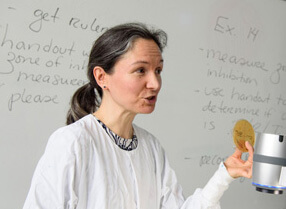
Professor Sarah Selke teaching Microbiology.
After all, he teaches a course called Emerging Infectious Diseases.
The University of Connecticut professor had been reading reports since the beginning of December, and with UConn classes starting in late January, he was ready to “seamlessly integrate the topic into the course” on day one. This is the fifth time he has taught the class, and information about SARS and MERS were already major topics.
For years, he would preach to his class in a lecture at the end of the semester “that it was only a matter of time before another outbreak with one of these viruses was going to cause a devastating global pandemic,” Szczepanek said in an email to The Day. “Welcome to 2020.”
From what he’s heard from students, the class helps them deal with difficult emotions that come with the pandemic. He thinks it gives them peace of mind to study how diseases emerge from an objective point of view.
Szczepanek also teaches a course on vaccines, and he’s one of multiple professors teaching a recently developed interdisciplinary, free, one-credit undergraduate course on COVID-19.
Peter Diplock, assistant vice provost for excellence in teaching and learning, said this past week that the course, The COVID-19 Pandemic: Impacts on Health, Business and Society, has 4,000 students enrolled. He developed the course, which is running April 6 through May 1.
It brings together professors in public health, public policy, pharmacy, finance and more. Diplock said a similar course for faculty, staff and graduate students begins Monday.
“Learn from UConn experts the science behind COVID-19, how to recognize stress and adopt coping mechanisms, and gain insight into the business and financial implications of the pandemic,” the undergraduate course description reads.
At Three Rivers Community College, Sarah Selke considered making the rest of the semester a COVID-19 case study in her microbiology class, but she opted to stick with her normal curriculum and weave the coronavirus in as examples.
“I think there’s a balance that I want to strike,” she said, “because knowledge is power, and I hope that learning more about the biology of COVID-19 actually reassures my students, but at the same time, the pandemic is inescapable.”
One time she used the coronavirus as an example was in talking about how alcohol is used to control microorganisms, and how alcohol can break apart the outer layer on some viruses.
“It’s called an envelope, and if you destroy the envelope, a virus particle cannot infect,” Selke explained. She ordinarily might use a bacterial example, but now, she explained to her students that people are using hand sanitizer because its alcohol content would destroy the envelope of the coronavirus.
Selke also will tie in the coronavirus to the chapter she’s teaching on how viruses replicate, one she said is always very challenging for her students.
“I am thinking that the fact I will be tying it to COVID-19 will make them more invested in the hard work they have to do to understand a difficult concept,” Selke said.
At Connecticut College, the courses don’t even have to be on health or science to tie in the coronavirus: Two English professors are incorporating it in their curriculum.
Jeff Strabone teaches Media Rhetoric and Communication, a course designed to teach students “to recognize the interests that influence journalism and public speech,” he said.
Earlier in the semester, students analyzed parts of President Donald Trump’s State of the Union address and Rep. Adam Schiff’s closing speeches in Trump’s impeachment trial. Strabone had them read primary documents on the impeachment and then read articles from slanted sources, from Jacobin to Breitbart, to see how those organizations interpreted the same documents.
Before spring break, Strabone already had started incorporating examples of coronavirus misinformation.
With the class online since spring break, students have talked about the Defense Production Act and about the dynamic between Trump and Anthony Fauci, director of the National Institute of Allergy and Infectious Diseases.
He gave his students 55 accounts to follow on Twitter — including elected officials, news organizations and advocacy groups — for them to consider which ones they should unfollow for spreading misinformation.
“COVID-19 is an epidemic, but it’s also a media event, so we need to think critically about the media that accompanies the epidemic,” Strabone said, adding, “Misinformation can kill you.”
Julie Rivkin is incorporating COVID-19 into her course on narrative medicine, an interdisciplinary field centered on patients voicing their experiences, thus improving health care services.
Some of the readings have included “Floating Bridge” by Alice Munro, “The Aquarium” by Aleksandar Hemon and “The Interior Castle” by Jean Stafford. After the mid-term, Rivkin decided to change the name of her course to Living in a Pandemic in Real Time.
“Both our public and our personal narratives are undergoing radical and extraordinarily rapid changes day by day and hour by hour,” Rivkin said. So, she’s having students share personal reflections that are guided by previous readings.
One assignment was for students to write about how their sense of time has been altered by the pandemic, and another was to respond to poetry that New York Times readers had written in response to the article “The Doctor and ‘The Apocalypse,'” in which a Boston emergency room doctor wrote a poem about the coronavirus crisis.
“The students have been wonderfully responsive, and I think they make it clear this work is helping them,” Rivkin said. “It’s kind of a space for them to make sense of what they’re going through.”
— By Erica Moser, The Day staff writer
The original article can be found here: “For some local colleges, COVID-19 is now part of the curriculum”
READ MORE
In the News | World responding to Lebanon man’s design increasing capacity of ventilators
Lebanon, CT (The Day, April 2, 2020) — Robert Conley’s exhausted.
His phone hasn’t stopped ringing since news reports this past weekend of his role in designing the Ventilator Quad Splitter, a device that can connect a single breathing machine to as many as seven or eight COVID-19 patients at the same time.
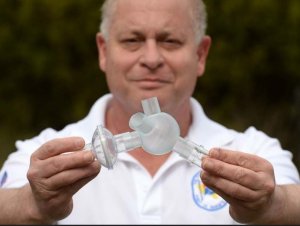
Robert Conley of Lebanon, owner of Interactive CAD Solutions, on Wednesday, April 1, 2020, holds the ventilator quad hose splitter, the white piece, that he designed attached to a stock HEPA filter and a stock coupling that connects to a ventilator (Dana Jensen/The Day).
Conley, 56, an associate professor at Three Rivers Community College in Norwich and owner of Interactive CAD Solutions, an engineering design company in Lebanon, said Wednesday he’s had inquiries from Italy, Germany, Saudi Arabia, the Philippines and Pakistan in the last couple of days from people interested in his splitter design, which can be produced on 3D printers.
With ventilators in notoriously short supply, the invention’s impact could be far-reaching.
Conley said he got involved in the project last week by responding to another small businessman’s plea. Kevin Dyer, chief executive officer of InterPRO Additive Manufacturing Group in Deep River, a 3D printing firm, was looking for help designing a valve that could increase a ventilator’s capacity. Dyer had answered the call of a pulmonologist at Manchester Hospital, Dr. Saud Anwar, a Democratic state senator from South Windsor.
Conley sent Dyer his first design last Thursday. Dyer printed a prototype the next day, and he and Conley promptly presented it to doctors at Manchester Hospital.
The doctors had some initial issues with the valve, saying the air pathways to and from each patient had to have air-purifying filters, Conley said.
It took him a couple of hours to redo his design.
“Kevin (Dyer) printed it overnight and on Saturday, they tested it at the hospital,” Conley said. “It worked pretty good.”
Anwar demonstrates the device in a YouTube video at bit.ly/CVventilator.
“We want to show how you can actually use one ventilator to give breathing capacity and help to not one, not two, not three, not four, not five, but actually seven people, and we can go up to eight if we need to,” Anwar says in the video. “We’ve been working collaboratively together … people of all different backgrounds.”
A Navy veteran who served on the USS Dallas, a nuclear-powered attack submarine, Conley said he has no intention of profiting from sales of his design, should the Ventilator Quad Splitter gain regulatory approvals.
“I’m not going to patent it,” he said of his design. “Anybody with a 3D printer can print it out and start making these.”
A diabetic, Conley said he’s emulating the doctors who discovered insulin, the treatment for diabetes, who he said declined offers of financial reward.
“That was such an important discovery, they wanted to share it with the world,” he said. “This is my gift to the world.”
— By Author Brian Hallenbeck, Day Staff Writer
The original article can be found here: “World responding to Lebanon man’s design increasing capacity of ventilators”
In the News | COVID-19 Update: Connecticut Engineer, 3D Printer Answer Doctor’s Call to Create Ventilator Splitter
Norwich, CT (CT News Junkies, March 29, 2019) — State Sen. Saud Anwar, whose day job as a medical doctor specializing in lung disease and critical care has kept him extremely busy over the past several weeks, shared what may be a big breakthrough Saturday in the effort to prepare for a surge in acute cases of COVID-19.
In a video posted to his Facebook page from Manchester Memorial Hospital, Anwar details a new, open-source 3D-printed valve – the Ventilator Quad Splitter – that could allow a single ventilator to treat up to seven patients per unit.
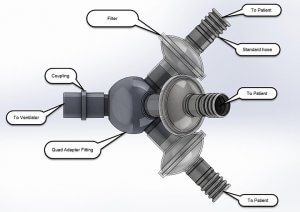
Conley’s illustration of his Ventilator Quad Splitter design (contributed photo)
“We’ve been working collaboratively together as a group of people from different backgrounds to get this done,” Anwar said.
Ventilators – which keep people alive when their lungs have failed – are in high demand at acute care hospitals with the spread of COVID-19. Manufacturers of many types are working around the clock to convert their production lines with a goal of making new ventilators.
But that may take too long, so Anwar posted a request for help last week with a goal of increasing the capacity of the ventilators that are already in use.
Anwar’s request was posted in some user groups online and was seen by Kevin Dyer, CEO at InterPRO Additive Manufacturing Group in Deep River, which uses 3D printing to create new parts and products.
Things moved pretty quickly from there.
Dyer also did some outreach and said he would print a prototype if someone would help with design. He found Robert Conley, a mechanical design engineer who is an associate professor at Three Rivers Community College and also has his own design firm, Interactive CAD Solutions. Conley, of Lebanon, started designing the new valve apparatus Wednesday, completing it Thursday and transmitting the specifications to Dyer.
Conley said Dyer then printed the valve overnight and handed it to him outside Manchester Memorial Hospital on Friday morning.
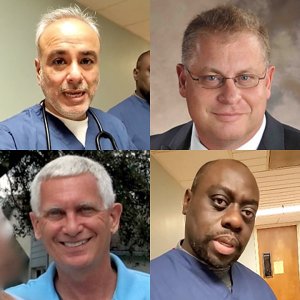
Clockwise from top left: Anwar, Conley, Bristol, and Dyer (contributed photos)
“I went in and met with Saud,” Conley said, adding that there were some initial issues. He noted some new information about how the ventilators function, including the requirement that each inlet and outlet must have a HEPA filter. The valve was designed using the Nellcor Puritan Bennett 840 Ventilator System. However, Conley said the fitting is based on a standard 15mm diameter, which he said is a universal size in ventilators of this type.
Conley said he redesigned it Friday afternoon with more room for the HEPA filters and at 4 p.m. sent the new specs to Dyer, who then produced the new model overnight.
On Saturday, Anwar posted the video showing the functional Ventilator Quad Splitter.
“This valve actually has four options, so we can have four connectors with just one ventilator and each connector can further be divided into two or more branches if we need to,” Anwar said. “It can provide breathing capacity and help to not one, not two, not three, not four, not five, but actually seven people and can go up to eight if we need to.”
Anwar added that each patient gets “a volume based on the exact settings that we have set up.”
The valve is a prototype and will need regulatory approvals before it can be sold, but Respiratory Specialist Marvin Bristol, who appeared in Anwar’s video, said the valve works.
“It’s just a concept that works in a simulation, and if it comes down to mass casualties this is a concept that I believe can be tried in the field, if need be, to have a clinical trial,” Bristol said. “The concept works.”
Anwar said that they were able to lengthen the tubes to 20 feet without losing pressure.
Conley also added that the design is open source, and the files for 3D printing are available on his website at intcadsol.com/ventilator-quad-splitter.
With all that said, the idea of increasing individual ventilator capacity was a cause of concern last week from several groups within the medical community. The Society of Critical Care Medicine, the American Association for Respiratory Care, the American Society of Anesthesiologists, the Anesthesia Patient Safety Foundation, the American Association of Critical‐Care Nurses, and the American College of Chest Physicians issued a consensus statement on March 26 against the concept of placing multiple patients on a single mechanical ventilator.
They said sharing mechanical ventilators should not be attempted because it cannot be done safely with current equipment, and recommended that clinicians not attempt to ventilate more than one patient with a single ventilator while any clinically proven, safe, and reliable therapy remains available.
— By Walker Strong, CT News Junkies writer
The original article can be found here: “COVID-19 Update: Connecticut Engineer, 3D Printer Answer Doctor’s Call to Create Ventilator Splitter”
Watch this Fox 61 New story on Conley and the Ventilator here, “Ventilator invention: Yankee ingenuity may allow one ventilator to help 7 patients.”
.
READ MORE14 Free Seminars that Address Today’s Biggest Environmental Issues
Join us for fourteen free seminars on some of the biggest environmental issues challenging us today. Topics range from Bird Conservation to Approaches to Eating in the United States: Consequences for our Health and Environment, and Global Climate Change to Our Ancient Culture, taught by a range of experts in their fields. Congressman Joe Courtney will also address Earth Day … 50 years! Environmental Issues in Connecticut and in the USA on April 8. Seminars are held in room C101 at Three Rivers Community College on Wednesdays, from 6:00-8:30 p.m. Guests are encouraged to arrive promptly by 6:00 p.m.
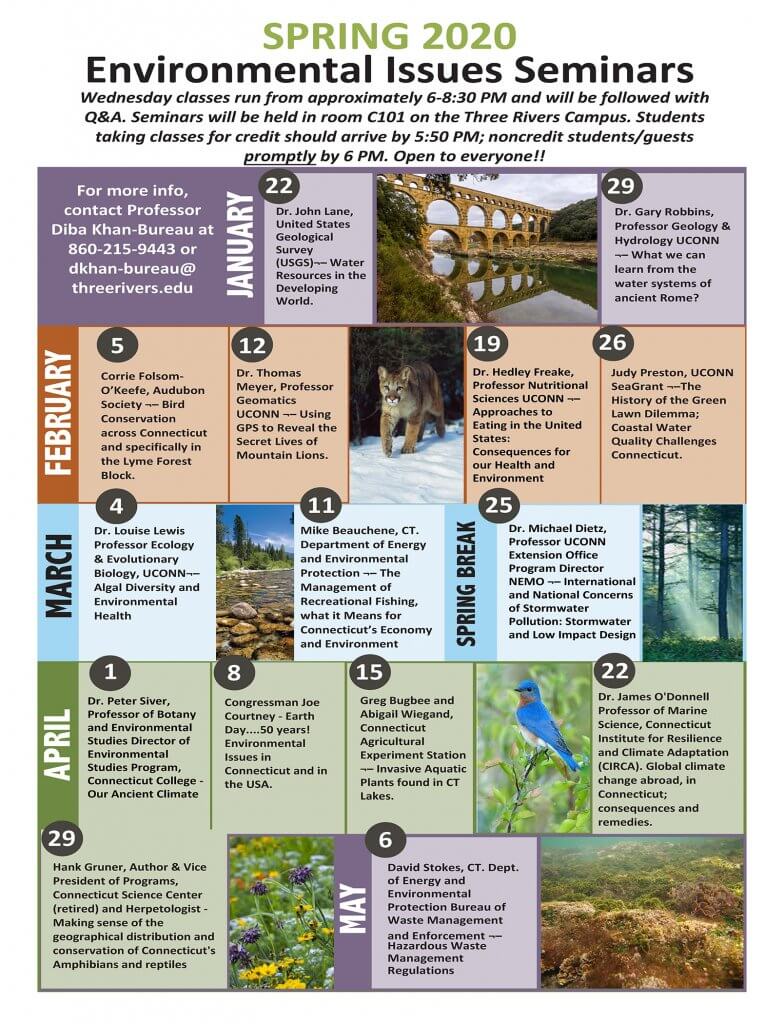 (Note: These talks are included in Environmental Issues Seminar (K295) and Environmental Science Seminars (BIO 289), which can also be taken as 3-credit courses. Call 860-215-9016 for more information.)
(Note: These talks are included in Environmental Issues Seminar (K295) and Environmental Science Seminars (BIO 289), which can also be taken as 3-credit courses. Call 860-215-9016 for more information.)
A full list of seminars and lecturers is included below:
January 29 – What We Can Learn from the Water Systems of Ancient Rome – Dr. Gary Robbins, Professor of Geology & Hydrology, UCONN
February 5 – Bird Conservation across Connecticut and specifically in the Lyme Forest Block – Corrie Folsom-O’Keefe, Audubon Society
February 12 – Using GPS to Reveal the Secret Lives of Mountain Lions – Dr. Thomas Meyer, Professor of Geomatics, UCONN
February 19 – Approaches to Eating in the United States: Consequences for our Health and Environment – Dr. Hedley Freake, Professor of Nutritional Sciences, UCONN
February 26 – The History of the Green Lawn Dilemma: Coastal Water Quality Challenges in Connecticut – Judy Preston, UCONN Sea Grant
March 4 – Algal Diversity and Environmental Health – Dr. Louise Lewis, Professor of Ecology & Evolutionary Biology, UCONN
March 11 – The Management of Recreational Fishing: What it Means for Connecticut’s Economy and Environment – Mike Beauchene, CT Department of Energy and Environmental Protection
March 25 – International and National Concerns of Stormwater Pollution: Stormwater and Low Impact Design – Dr. Michael Dietz, Professor, UCONN Extension Office Program Director of NEMO
April 1 – Our Ancient Climate – Dr. Peter Siver, Professor of Botany and Environmental Studies, Director of Environmental Studies Program, Connecticut College
April 8 – Earth Day … 50 years! Environmental Issues in Connecticut and in the USA -Congressman Joe Courtney
April 15 – Invasive Aquatic Plants found in CT Lakes – Greg Bugbee and Abigail Wiegand, Connecticut Agricultural Experiment Station
April 22 – Global Climate Change Abroad and in Connecticut: Consequences and Remedies – Dr. James O’Donnell, Professor of Marine Science, Connecticut Institute for Resilience and Climate Adaptation (CIRCA)
April 29 – Making Sense of the Geographical Distribution and Conservation of Connecticut’s Amphibians and Reptiles – Hank Gruner, Author, Vice President of Programs, Connecticut Science Center (retired), and Herpetologist
May 6 – Hazardous Waste Management Regulations – David Stokes, CT Department of Energy and Environmental Protection Bureau of Waste Management and Enforcement
The seminars are coordinated by Diba Khan-Bureau, Professor of Environmental Engineering Technology, and are free and open to the public. For more info, contact Professor Diba Khan-Bureau at 860-215-9443 or dkhan-bureau@trcc.commnet.edu
READ MOREBiochemistry Studies, A.A. – CSCU Pathway Transfer Degree
[mk_page_section bg_image=”https://threerivers.edu/wp-content/uploads/2020/02/360croppedto1450x464.jpg” bg_position=”center top” bg_repeat=”no-repeat” bg_stretch=”true” full_width=”true” padding_top=”0″ padding_bottom=”0″ top_shape_color=”#ffffff” bottom_shape_color=”#ffffff” el_class=”header-section” sidebar=”sidebar-1″][vc_column][vc_empty_space height=”450px”][mk_fancy_title strip_tags=”true” color=”#ffffff” size=”80″ font_weight=”bold” txt_transform=”uppercase” margin_bottom=”0″ font_family=”Oswald” font_type=”google” el_class=”page-title”]- Biochemistry Studies, A.A. – CSCU Pathway Transfer Degree
This program is designed to provide you with a strong foundation in the area of Biochemistry. Through your course work, you will gain insight into the chemical processes and reactions that take place within living organisms. Upon completion of this Transfer Ticket Biochemistry Studies degree program, you will be able to transfer seamlessly to colleges within the Connecticut College State University system, being guaranteed full junior status in your pursuit of a bachelor’s degree in the same discipline, without losing any credits or being required to take extra credits upon transfer.
[/vc_column_text][vc_separator][mk_fancy_title color=”#cb1d5c” size=”30″ margin_bottom=”0″ font_family=”Oswald” font_type=”google”]Special Opportunities[/mk_fancy_title][vc_column_text]With this degree, you will be able to transfer, apply to competitive admissions majors, and complete your BA/BS degree in the same time and with the same course requirements as students who start at a CSU or COSC.
[/vc_column_text][mk_fancy_title color=”#cb1d5c” size=”30″ margin_bottom=”0″ font_family=”Oswald” font_type=”google”]Career Options[/mk_fancy_title][vc_column_text css=”.vc_custom_1576778941234{margin-bottom: 0px !important;}”]Biochemistry TechnicianMedical or Clinical Laboratory Technician[/vc_column_text][mk_fancy_title color=”#cb1d5c” size=”30″ margin_bottom=”0″ font_family=”Oswald” font_type=”google”]Easy Transfer Options[/mk_fancy_title][vc_column_text css=”.vc_custom_1634046645855{margin-bottom: 0px !important;}”]
These degrees guarantee full junior status, no loss of credits, and no need to take extra credits.
Central Connecticut State University – Biochemistry – General Track, B.S.; Biochemistry – American Chemical Society Certified, B.S.
Eastern Connecticut State University – Biochemistry, B.S.
Southern Connecticut State University – Chemistry – Concentration: Biochemistry, B.S.
Western Connecticut State University – Biochemistry – Non-American Chemical Society Approved, B.S.; Biochemistry – American Chemical Society Approved, B.S.
Technology Studies: Biomolecular Science Option, A.S.
Nursing, A.S.
General Studies, A.S.
General Studies Certificate
See below for a list of all full-time Department Faculty. Please note that not all listed faculty may teach courses related to this specific degree or certificate program.
Median Salary*[/vc_column_text][vc_column_text css=”.vc_custom_1577976409207{margin-bottom: 20px !important;}”]
CONTACT
*Source: U.S. Bureau of Labor Statistics
[/vc_column_text][/vc_column][/vc_row] READ MOREIn the News | Three Rivers quadcopter team takes first place
Norwich, Connecticut (The Day, May 17, 2019) —A team from Three River Community College that included five local students tied for first place in the annual NASA-sponsored Community College Quadcopter Challenge April 26 at Quinebaug Valley Community College in Danielson.

The Thames River Community College drone team, from left, Daniel Docker of New London, Adam Rugh of Old Mystic, Kevin Peterson of New London, Jonathan Bermudez of Norwich and Nate Reigles of Oakdale, along with advisor Yevhen Rutovytskyy. (Photo submitted)
Students were Adam Rugh of Old Mystic, Nate Reigles of Oakdale, Kevin Peterson and Daniel Docker of New London and Jonathan Bermudez of Norwich. The final two students were military veterans.
The team, led by Electric Boat engineer and adjunct professor Yevhen Rutovytskyy, tied QVCC, which had won the three previous drone challenges.
Each team member put in between 80 and 100 hours of work into into the drone, and each student will receive a $1,000 stipend.
The project is intended to increase the number of science, technology, engineering and math graduates, raise awareness of NASA education initiatives, enhance STEM diversity and provide experience with computer-aided drafting software.
“As a senior engineer at a defense contractor, my goal is to help students transcend their ‘comfort zone’ and learn skills that are not ordinarily offered as part of the engineering curriculum in community colleges,” Rutovytskyy, a Colchester resident, said in an email.
Part of the challenge included fabricating a multi-positional camera mount to allow the drone operator to manually switch camera views and acquire in-flight pictures of various targets of interest.
The original article can be found here: ‘Three Rivers quadcopter team takes first place’
READ MORE